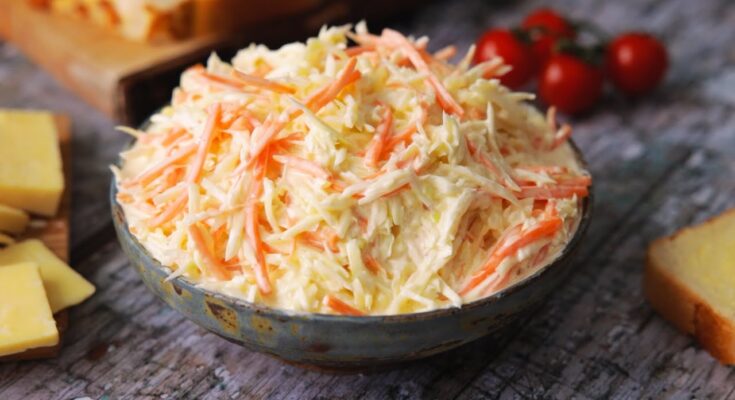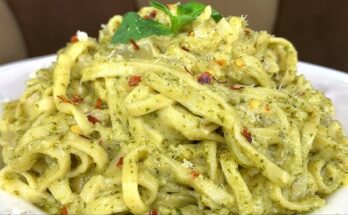Slaw Dressing Recipe: Slaw dressing is a creamy, tangy, and slightly sweet mixture used to dress shredded vegetables—most often cabbage and carrots—to create a refreshing and crunchy side dish known as coleslaw. While store-bought versions are convenient, homemade slaw dressing offers unbeatable freshness and allows for total control over flavor, sweetness, and creaminess.
But it’s not just for coleslaw! A good slaw dressing can be a game-changer for burgers, wraps, tacos, and even as a dipping sauce for fried foods. It adds moisture, enhances texture, and ties together the flavors of your dish like magic.
Ingredients Needed for Classic Slaw Dressing
Here’s a basic list of ingredients you’ll need to create a delicious and creamy slaw dressing. Most of these items are pantry staples, making this an easy recipe to whip up on a whim.
Essential Ingredients:
- Mayonnaise – ½ cup (creamy base)
- Apple cider vinegar – 2 tablespoons (adds acidity and tang)
- Sugar – 1 tablespoon (for sweetness and balance)
- Dijon mustard – 1 teaspoon (for a slight kick)
- Salt – ½ teaspoon (to enhance flavor)
- Black pepper – ¼ teaspoon (adds a mild spice)
Optional Add-ons for Customization:
- Celery seed – for a classic touch and a bit of crunch
- Greek yogurt – substitute for mayo to make it lighter
- Buttermilk – for an extra creamy and tangy finish
- Hot sauce or cayenne pepper – if you like heat
- Garlic powder or onion powder – adds depth of flavor
These ingredients offer a well-balanced profile of tangy, sweet, creamy, and savory—all the elements that make slaw dressing so addictive.
Step-by-Step Instructions for Making Slaw Dressing
Step 1: Gather Your Ingredients
Before you start mixing, it’s a good idea to get all your ingredients ready and measured out. This makes the process smooth and ensures you don’t forget any key elements. Use fresh, high-quality mayonnaise and vinegar for the best flavor.
Step 2: Combine the Base Ingredients
In a medium-sized mixing bowl, whisk together the mayonnaise, apple cider vinegar, and sugar until smooth. The vinegar will thin out the mayo and help dissolve the sugar. This step is crucial because it forms the base of your dressing.
Next, stir in the Dijon mustard, salt, and pepper. The mustard adds depth and sharpness, balancing out the richness of the mayo. Taste the mixture at this stage—it should be tangy, slightly sweet, and creamy.
Step 3: Adjust Seasoning to Taste
Now is the time to get creative. Do you prefer a little more tang? Add another splash of vinegar. Want it sweeter? Another teaspoon of sugar won’t hurt. Like a little heat? A pinch of cayenne or a few dashes of hot sauce will do the trick.
The beauty of homemade slaw dressing is in its adaptability. Make it yours by adjusting the ratios until it suits your palate perfectly.
Step 4: Chill Before Serving
Once your dressing tastes just right, cover the bowl and place it in the refrigerator for at least 30 minutes. This chilling time allows the flavors to meld together and the texture to thicken slightly. When you’re ready to use it, simply stir it up and pour it over your slaw mix.
Tips for the Perfect Slaw Dressing
Creating a restaurant-quality slaw dressing at home is easier than you think. Here are a few pro tips to elevate your homemade version:
- Use full-fat mayo for the creamiest texture. Light versions are fine, but they can thin out the dressing.
- Balance is key. Too much sugar or vinegar can overpower the dish. Add slowly and taste often.
- Always chill the dressing before mixing it with slaw vegetables. Warm dressing can make your coleslaw watery.
- Toss just before serving to avoid soggy cabbage. The longer it sits, the softer the veggies become.
- Store in an airtight container in the fridge for up to 5 days. Stir before each use.
Variations of Slaw Dressing
Everyone has their favorite version of slaw dressing. Whether you love it creamy, tangy, sweet, or spicy, here are some variations to explore:
Creamy Slaw Dressing
This version uses mayonnaise, a little sour cream or Greek yogurt, and buttermilk. It’s richer and thicker, great for traditional BBQ-style coleslaw.
Vinegar-Based Slaw Dressing
Skip the mayo and mix vinegar (apple cider or white), olive oil, sugar, salt, and pepper. This lighter version is popular in Southern cooking and perfect for pulled pork sandwiches.
Spicy Slaw Dressing
Add chopped jalapeños, cayenne pepper, or a squirt of sriracha to the classic recipe. It pairs well with tacos, fish sandwiches, or anything that could use a fiery kick.
How to Use Slaw Dressing in Different Dishes
Slaw dressing is incredibly versatile. It’s not just limited to the classic cabbage slaw. Here’s how you can use it to elevate other dishes:
1. Classic Coleslaw
Toss shredded green and red cabbage with carrots and your slaw dressing for a perfect BBQ side. It’s crisp, creamy, and tangy—the perfect complement to grilled meats and sandwiches.
2. Fish Tacos
A creamy slaw with a spicy kick goes perfectly with crispy fish in soft tortillas. The cool crunch balances the heat and texture of the fish.
3. Pulled Pork Sandwiches
Add a generous heap of slaw made with vinegar-based dressing on top of pulled pork for a smoky-sweet combo that’s hard to resist.
4. Wraps and Burgers
Use slaw as a topping in wraps or burgers instead of lettuce. It adds a flavorful crunch and extra moisture that makes every bite better.
5. Rice Bowls
Looking to add crunch and creaminess to a healthy bowl? A small scoop of slaw on top of grilled chicken or tofu bowls brings a fresh zing.
This shows how slaw dressing can upgrade the flavor profile of your meals in a subtle yet powerful way.
Nutritional Information of Slaw Dressing
Understanding what goes into your slaw dressing also means understanding its nutritional impact. Here’s a general breakdown based on a standard serving of about 2 tablespoons:
| Nutrient | Approx. Value |
|---|---|
| Calories | 120–150 kcal |
| Fat | 12–14g |
| Carbohydrates | 2–4g |
| Sugar | 1–3g |
| Protein | 0–1g |
| Sodium | 100–250mg |
Keep in mind, if you’re customizing your dressing with ingredients like Greek yogurt or reducing sugar, the values can change. For a healthier version, you can swap full-fat mayo with low-fat or plant-based alternatives.
Make-Ahead and Storage Tips
A good slaw dressing keeps well, which makes it perfect for meal prep. Here’s how to store it and make it ahead:
- Refrigeration: Store it in an airtight jar or container for up to 5 days.
- Separation: Some ingredients may separate over time. Just give it a good stir before each use.
- Batching: Make a double batch and use it throughout the week to dress salads, slaws, or as a dip.
Avoid freezing slaw dressing as it contains mayo, which doesn’t hold up well in the freezer and may separate upon thawing.
Common Mistakes to Avoid
Even though slaw dressing is simple, a few common mistakes can throw off your final dish:
Over-sweetening
Adding too much sugar can make your slaw taste more like dessert. Always start small and add more to taste.
Not tasting as you go
It’s crucial to taste your dressing at different stages to balance flavors.
Skipping the chill time
Slaw dressing needs time to let the flavors meld. Skipping this step results in a flat-tasting mix.
Using low-quality mayo
This can totally change the texture and taste. Always use a brand you trust or make homemade mayo if you’re feeling ambitious.
Avoiding these mistakes ensures your slaw dressing is flavorful and well-balanced every time.
Why Homemade Beats Store-Bought
Store-bought slaw dressing might be convenient, but it doesn’t hold a candle to homemade when it comes to freshness and flavor. Here’s why making it yourself is the better choice:
- No preservatives or additives
- Customizable to suit dietary needs (low sugar, vegan, dairy-free, etc.)
- Better texture and flavor control
- More economical if you’re making large batches
Plus, once you’ve mastered the base recipe, you can tweak it endlessly and never get bored.
FAQs about Slaw Dressing Recipe
1. What is slaw dressing made of?
Slaw dressing typically includes mayonnaise, vinegar (like apple cider or white vinegar), sugar, salt, and pepper. Some variations add mustard, celery seed, or a splash of lemon juice for extra tang.
2. Can I make slaw dressing without mayo?
Yes, you can substitute mayonnaise with Greek yogurt, sour cream, or even olive oil for a lighter, healthier version of slaw dressing.
3. How long does homemade slaw dressing last?
When stored in an airtight container in the fridge, homemade slaw dressing can last up to 5–7 days. Always check for smell or separation before using.
4. Is slaw dressing gluten-free?
Most slaw dressings are naturally gluten-free, but always check the labels of any store-bought ingredients like mayo or vinegar to be sure.
5. Can I use slaw dressing for other salads?
Absolutely! Slaw dressing works great on broccoli slaw, shredded carrot salad, or as a tangy dip for grilled veggies.
Conclusion
Slaw dressing might seem like a humble condiment, but it’s the secret weapon in many memorable meals. Whether you’re making a crunchy slaw for a picnic, a spicy taco topping, or a creamy spread for burgers, this simple dressing pulls its weight. The best part? It’s easy to make, endlessly customizable, and miles ahead of store-bought versions.
Master this recipe, and you’ll never go back to the bottled stuff again. Just a few ingredients and a bit of whisking, and you’ve got yourself a versatile dressing that brings life to countless dishes.



